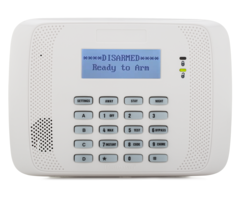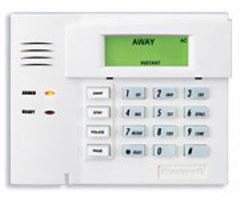How to Tell If a Keypad Has an RF Receiver Built-In
Related Products




Related Categories
Description
In this video, Jorge from Alarm Grid explains how to tell if the keypad for a wired alarm panel has an RF receiver built-in. When a keypad on a wired panel has an RF receiver, it gives the system the ability to support wireless alarm sensors. Normally, a wired system can only support hardwired sensors. If you want to use wireless sensors on the system, then adding an RF receiver is required. You may also hear an RF receiver being referred to as a wireless receiver. And if the wireless receiver can send messages back to the sensor, then it is known as a wireless transceiver. Some sensors require the use of bi-directional transceivers, and they cannot be used with uni-directional, or one-way, receivers.
An example of a hardwired alarm system that can be upgraded to support wireless sensors is a Honeywell VISTA System. The VISTA Systems have certain keypad options that double as wireless receivers. One such keypad is the Honeywell 6160RF. The 6160RF Alphanumeric Keypad is used for controlling the Honeywell VISTA System, but it also has an integrated receiver. Once the keypad is properly set up with the system, you will also be able to start enrolling compatible wireless sensors. In the case of a Honeywell VISTA with an added receiver, the system will support 345 MHz wireless sensors from the Honeywell 5800 Series. But it can be a bit tricky to figure out if a 6160RF really has an RF transceiver built inside. This is because the 6160RF looks very similar to the standard 6160 Keypad model, which is the same keypad but without the integrated transceiver. Some ways that you can find out include checking the box for the keypad, checking its circuit board, looking for an RF antenna on the inside, and addressing the keypad with the system.
https://www.alarmgrid.com/faq/how-can-i-tell-if-my-keypad-has-an-rf-receiver-built-in
http://alrm.gd/get-monitored
Transcript
Hi, DIYers. Jorge here from AlarmGrid. Today, I'm going to be showing you guys how to identify if the keypad on your VISTA system has an RF receiver built-in. So the first thing we need to understand is, what is an RF receiver? RF stands for Radio Frequency. So what you're actually looking for is a radio frequency receiver inside one of your keypads. Now, this may be super hard to distinguish. Especially if you guys are moving to a house that already has an existing system, you guys don't know what the previous owner may have bought for the alarm-- Eagle system. So you're not sure exactly what to even start looking for. So very first thing is if you have a keypad with an RF receiver, there's no way to actually tell just by looking at the keypads. As you see, this one's labeled. Fortunately for us, we made a 6160RF. But normal keypads won't have labels. They'll look something like this probably. So the quick, easy way to tell what keypad, or if you have an RF receiver built into your keypad, is to actually open the keypad up and see the inside-- if there's any antennas. You will also see the model number on the green circuit board or the motherboard on the inside of the keypad, as well. And for instance, this one, since it's a 6160RF, the model number will actually say, SA-- Sierra Alpha-- 6160RF. So I'm going to go ahead and before I open anything up here, I'm going to power the system down. So what you would typically do when you move into a home is you're going to find the power supply, the transformer for your VISTA system, and you're going to unplug that from the wall. Luckily for me, I have a easy adapter, which I can just unplug. And then unplug one of the leads from the backup battery, and everything shuts down. I recommend having a flathead screwdriver, because it's a lot easier to put into the little crack, twist, and pop each side open. You do want to work, when you're doing these keypads, from underneath. You're going to see two little tabs-- one on the left, one on the right. You're going to pop your flathead in. You're going to pop one side out. And then once that's out, you're going to pop the other side out. So give me just one second. That's one side, and then the other. Be very careful when you guys are taking the actual keypad off the back plate, because if there's not enough wiring that's behind the wall, you will feel it a little tight. And you don't want to pull too hard, because one of the wires might come loose. Luckily for this one, there is a little bit of excess wire, so I can actually pull it out and show you guys a perfect example of what an RF keypad will look like. So right off of the bat, you're going to see that the RF keypad has these little antennas going on the outside of the motherboard. If you don't see any antennas on the outside of the motherboard on your keypad, you do not have an RF receiver built-in. So and again, if you don't even see these, if your eyes don't happen to catch them, you can always look for the model number, which will be printed in black lettering on the motherboard. This is, again, SA6160RF-- RF, Radio Frequency. That means you have a receiver built into this keypad. So I'm going to go ahead and close this back up, and I'm going to show you what a non-RF keypad looks like. So to close that up, always put the top in first. And then let the bottom just snap in. So this here is just a fixed English keypad. And I'm going to go ahead and pop this out. This is a harder angle to work with. Let me see if I can get this. All right, perfect. This one came off a lot easier. I was playing with it a little bit before. This one, there's not much room to pull, so I'm going to go ahead and just try my best to flip it around here. It's actually backwards. Let me see if I can get this better view. You got to be very careful with this wiring. So if you see here on this one, one of the wires just came loose. So now I'm going to have to re-do the wiring on this so that it actually works when I power it back on. But if you see here, this says SA6150. If it doesn't say RF, don't get confused by what the other letters are. This one is just SA6150. There's no RF at the end, so we know that this is not an RF keypad. And so we're going to leave this here. We're going to get an error when we power it back on. The other way that you could possibly know whether or not you have an RF keypad is when you power it back on, you can press and hold 1 and 3. That will actually go into the addressing screen of the keypad, which you need to address a keypad when you install it into a system in order for the system to know where to look for that keypad. So this one is already addressed. But when I power it back on-- which one of my other wires just came loose here. So let me fix the wiring here real fast so that when we power it back on, everything will work. So now that we got the wiring all set back up, the keypad should go back into normal mode. Since we just powered it back on, I'm going to show you guys real fast the addressing, which is the other way that you can tell if you have RF. If you have an RF keypad, you're going to press and hold 1 and 3. That's what you use to address the keypads. Obviously, this is already addressed to 17. But if you hit star after you're finished with this and it goes back to the normal screen, that means you have a normal keypad. So this is if you don't want to open it up and check the back. This is if you just want to-- uh-oh-- this is if you just wanted to check the address. If you hit star and it doesn't give you these options-- this actually says, receiver on or off. That kind of lets you know, hey, I have an RF receiver built into this keypad. But if you didn't get that option, and you hit star after you saw that con address and it brought you back to the main screen, then that obviously means you guys don't have an RF receiver built-in to the keypads. Another RF receiver that is more commonly used in already existing installations are going to be the actual standalone receivers, which are the 5881ENL the 5881ENM, and the 5881ENH. These are different. There's other receivers, as well, but these are the more commonly used receivers, especially the 5881ENH, which is actually what's technically built into the 6160RF. But what you'll see, when you have a standalone receiver, is in the actual VISTA system, which is the beige metal cabinet that holds the brains of the system, you'll see two little antennas sticking out the very top. If you see anything with two little small antennas sticking out the top, that's probably a standalone receiver. You can open that up, check the inside, and if you see anything that says 5881, or 5883ENH, or anything like that, that means you have a standalone receiver, and they're probably not built into the keypads. And again, these receivers are used to add in wireless devices. So for people who are just buying a house, and moving in, and let's say there's an area that wasn't covered from the previous owner that you would like to cover. Or maybe there's not smoke detectors, and you guys want to add smoke detectors without having to run wires everywhere. It would be very easy to just buy a 6160RF, replace an old keypad, or check to see if you have a standalone receiver. If not, you can add one. And then once you have an RF receiver in your wired system, you can go ahead and add in any kind of wireless device that you guys want. If you guys have any other questions on how to figure out, or if you need help figuring out, what keypad, what system you have, you're looking for monitoring on a house you just moved in, feel free to email us to support@alarmgrid.com. If you found the video helpful, make sure you hit Like underneath, Subscribe to the YouTube channel, and hit that little bell icon to enable notifications so when we upload new content, you guys will get notified. I'm Jorge, and I'll see you guys next time.
- Uploaded
